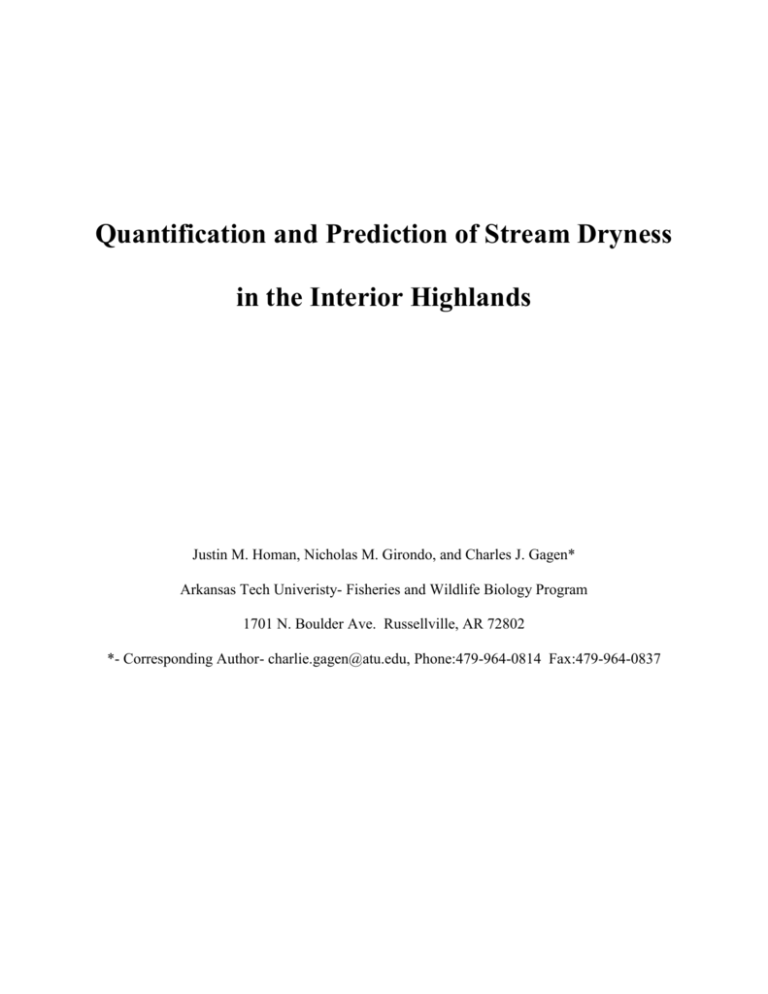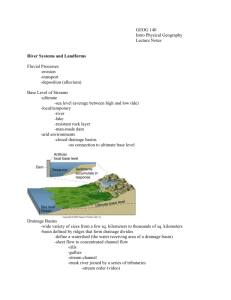Fisheries and Wildlife Biology Program
advertisement

Quantification and Prediction of Stream Dryness in the Interior Highlands Justin M. Homan, Nicholas M. Girondo, and Charles J. Gagen* Arkansas Tech Univeristy- Fisheries and Wildlife Biology Program 1701 N. Boulder Ave. Russellville, AR 72802 *- Corresponding Author- charlie.gagen@atu.edu, Phone:479-964-0814 Fax:479-964-0837 Abstract Although ecological studies have noted streams drying in the Interior Highlands, published measurements of streambed dryness are lacking. Clearly, stream drying has the potential to affect benthic macroinvertebrate and fish communities. In 2003, we initiated an assessment of streambed dryness for three streams in the Ouachita Mountains representative of the Central Hills, Ridges, and Valleys. In the following summer, we applied the approach to 15 similar size watersheds in three distinct ecoregions of the Interior Highlands: Ouachita Mountains-Athens Plateau, Ozark Highlands-Springfield Plateau, and Lower Boston Mountains. Repeated dryness measurements were recorded in each stream and correlated to nearby USGS stream gage records. Dryness reached as high as 86% for the Ouachita Mountains in 2003; whereas, flow was continuous in 2004. One stream in the Ozark Highlands dried completely in 2004, and dryness reached 84% in the Boston Mountains. Percent dry streambed was negatively correlated (Spearman rank) to discharge for the Ouachita Mountains in 2003 and the Boston Mountains in 2004 (rs = -0.94 and -0.60, respectively; p ≤ 0.01). Lowest monthly mean daily discharge, corrected for watershed area, differed among ecoregions for May through October in 2004 (highest discharge in the Ouachita Mountains, p ≤ 0.05, Tukey-Kramer). Maximum dryness during these months was significantly lower for the Ouachita Mountains than the Boston Mountains and Ozark Highlands. Thus, discernable patterns of stream dryness exist among the different ecoregions of the Interior Highlands. Aquatic ecologists and resource managers in these ecoregions could employ such measures to further understand habitat limitations associated with these stream systems. 1 Introduction Stream drying is a potentially important ecological phenomenon in Interior Highland streams due to the temporary loss of habitat that occurs as streams become desiccated. The extent of continuous surface flow reflects an interaction between several variables, such as precipitation, evapotranspiration, hydrogeologic pathways, and anthropogenic water use within a watershed. Extensive stream drying can lead to loss or isolation of habitats and possible mortality of aquatic macroinvertebrates and fishes. Recent studies in the Interior Highlands have investigated the consequences of stream drying on aquatic communities. Investigations considered the effect of pool connectivity on fish assemblages (Taylor, 1997), the interaction between fish and aquatic macroinvertebrates in intermittent streams (Williams et al., 2003), variation in fish assemblages in drying stream pools (Magoulick, 2000), and metapopulation dynamics of endemic species (Gagen et al., 1998). While these investigators provided detailed assessments of community characteristics, few physical measurements were provided to characterize the extent of dryness in the context of the stream network. Understanding key ecosystem processes that cause and maintain the association of habitat patches is important to management and understanding of stream fish populations (Schlosser and Angermeier, 1995). Thus, systematically assessing the extent of stream drying should contribute to understanding ecological processes within the Interior Highlands. The objectives of this study were to quantify stream drying within the Interior Highlands, to characterize possible drying patterns relative to major ecoregions within the Interior Highlands, and to predict the degree of stream drying from discharge data available from nearby United States Geological Survey (USGS) stream gages. 2 Materials and Methods We focused dryness measurements in the major upland ecoregions of the state. Ecoregions have been defined as regions that are relatively similar with respect to ecological processes involving interrelationships among organisms and their environment (Omernick, 1995). Omernick (1987) defined level III ecoregions of the United States on the basis that ecosystems and their components exhibit regional patterns that are reflected in spatially variable associations of underlying factors including mineral availability, climate, vegetation, and physiography. Woods et al. (2004) also defined subecoregions (level IV) in Arkansas based on landuse, wildlife, fish, and hydrology. We piloted methods for quantification of streambed dryness in the summer of 2003 and further applied the methods at a larger scale in the summer of 2004. We measured stream dryness in 2003 in three streams within the Ouachita Mountains (level III)-Central Hills, Ridges, and Valleys (level IV) ecoregion (Woods et al., 2004). These three streams drained relatively small watersheds (220 to 800 ha) within the Ouachita River drainage upstream of Lake Ouachita. In 2004, we measured stream dryness in 15 streams of similar size watersheds in three different ecoregions of the Interior Highlands. A study area in each ecoregion consisted of three streams at the 2,800 ha watershed size and two streams at the 5,600 ha watershed size. The five streams in the Ouachita Mountains (level III)-Athens Plateau (level IV) were tributaries of the Cossatot River, and were expected to remain perennial throughout the year (Hines, 1975). We selected five streams in the Ozark Highlands (level III)- Salem Plateau (level IV); three were tributaries of North Sylamore Creek (two 2,800 ha and one 5,600 ha), whereas the other two were within adjacent Livingston Creek drainage (one 2,800 ha and one 5,600 ha). We expected streams in this ecoregion to have an intermediate level of baseflow in the summer (Hines, 1975). We also 3 measured five streams in the Boston Mountains (level III)-Lower Boston Mountains (level IV) ecoregion. These were tributaries to the Illinois Bayou, which was known to have little baseflow in the summer (Hines, 1975). The method of measurement of stream dryness was the same for both years of the study. For a 2-km study reach beginning at the watershed boundary, one person walked upstream with a hip-chain recording the length of each wet or dry section. We considered a section of streambed dry where no surface water was visible across the width of the streambed. In 2003, dryness was measured once in June and twice in July in all three creeks. A fourth measurement was recorded for one creek (Rocky Creek) in September. In 2004, all creeks were sampled from June through October with a minimum of four samples per stream. All study sites in 2003 and 2004 had nearby USGS stream gages on larger tributaries. Distance from beginning of watershed boundary to gages ranged from 5 to 41 km. We used regression analysis to search for relationships between our dryness measurements and published discharge data from these stream gages. Discharge data from the USGS gages were available online for 2002 to 2004 at (http://water.usgs.gov/pubs/wdr/#AR) and for previous years at (http://nwis.waterdata.usgs.gov/usa/nwis/discharge). We expressed stream discharge from these reference gages as L/sּhaֿ¹ to facilitate comparison among USGS watersheds of different sizes. We used the Kruskal-Wallis test to evaluate differences in percent streambed dry and discharge at reference gages between ecoregions in 2004. We made multiple comparisons of ecoregions by applying the Tukey-Kramer test to rank-transformed data (Conover and Iman, 1981). We selected the lowest mean daily discharge (L/sּhaֿ¹) for each month from June through October as an index of low discharge. We compared the low discharge index among ecoregions in the same manner as for the dryness index. 4 We used correlation and regression analyses to examine relationships between percent dry streambed and low discharges at reference gages. To determine if there was a relationship between percent dry streambed and reference discharge, we used Spearman rank correlation for each stream in each ecoregion. We also used linear regression analysis to predict percent stream dryness from reference discharge. We transformed discharge to its reciprocal (1/Lּsּhaֿ¹) to produce a more linear relationship. These empirical regression equations were used to estimate percent dry streambed during past years. For ecoregion comparisons we also arbitrarily selected the number of days each creek was at least 25 percent dry as a criterion likely to have ecological relevance (Q @ ≥ 25%). To determine the Q @ ≥ 25% dry, we used the linear equation from the regression analyses. All statistical analyses were performed using Number Cruncher Statistical Software (Hintze, 1995). Results and Discussion Stream dryness and discharge at reference gages varied among ecoregions. Streamflow was continuous along the lengths of Ouachita Mountains-Central Hills, Ridges, and Valleys streams when the study began in June 2003; however, dryness reached as high as 86% by September (Fig. 1). In 2004, streams of the Ouachita Mountains-Athens Plateau flowed continuously whereas, dry reaches appeared in streams of the Lower Boston Mountains and the Ozark Highlands-Springfield Plateau. All but one stream in the Lower Boston Mountains had continuous surface flow at the start of the 2004 study, and each stream dried gradually throughout the summer becoming up to 84% dry (Fig. 1). Dryness ranged from 0 to 100% for streams draining the karst watersheds of the Ozark Highlands-Springfield Plateau; however, the pattern of wet and dry reaches was well established at the beginning of the study and fluctuated little during the remainder of the study (Fig. 1). For similar size watersheds, the maximum 5 percentage of dry streambed was significantly different among ecoregions with the Lower Boston Mountains (driest), Ouachita Mountains-Athens Plateau (wettest), and the Ozark Highlands-Springfield Plateau (intermediate; p < 0.05). The minimum mean daily discharge at reference gages also varied significantly across ecoregions and followed the pattern indicated by dryness percentages (p < 0.05, using a single value per month calculated as L/sּha-¹( . Stream dryness was related to discharge at reference gages (L/s·ha-¹) in 2003 and 2004. Percent dry streambed for 2003 in the Ouachita Mountains-Central Hills, Ridges, and Valleys ecoregion was negatively correlated to minimum mean daily discharge at the reference gage (rs = -0.94, p < 0.01). In contrast the Athens Plateau portion of the Ouachita Mountains ecoregion showed no dryness in 2004, which precluded any search for correlation with discharge. We attributed these differences in summer streamflow to hydrogeologic differences between the level IV sub-ecoregions, even though both are within the same level III (Ouachita Mountains) ecoregion. In the Lower Boston Mountains, dryness was negatively correlated with discharge (rs = -0.60, p<0.01). However, dryness was not related to discharge in the Ozark Highlands-Springfield Plateau (rs = -0.01, p = 0.98). In this ecoregion the karst conditions likely contributed to the observed patterns of headwaters being almost always dry and larger streams being almost always wet. That is, portions of these streams flow underground except during stormflow. Thus, of the four studied ecoregions, flow was relatively constant for two (one had continuous (perennial) flow and the other had both perennial reaches and completely dry reaches). Surface flow in the other two ecoregions was discontinuous in time and space and was highly correlated with an index of low discharge at nearby reference gages. Based on the correlation between % dry streambed and low discharge at reference gages in the Ouachita Mountains-Central Hills, Ridges, and Valleys (2003) and the Lower Boston 6 Mountains (2004), we attempted to predict dryness for each stream. The linear regression analyses resulted in a minimum R² = 0.74 for the eight streams when the low discharge variable was transformed to its reciprocal. Low sample sizes limited p-values for significance of slope in some cases, but we considered the empirical relationships to be relevant to natural hydrologic processes. We used these empirical relationships to estimate discharge at 25% dry (Q @ 25% dry) for each study stream. There was not a specific level of discharge at which all of the streams within an ecoregion began to dry, and dryness was not consistently related to watershed size in this study. By searching past discharge records, we estimated how many days each stream was ≥ 25% dry during 2000, 2003, and 2004. The amount of time ≥ 25% dry was determined for all three streams in the Ouachita Mountains-Central Hills, Ridges, and Valleys and for five streams in the Lower Boston Mountains (Fig. 2). Streams in the Lower Boston Mountains reached 25% dry at lower levels of discharge than streams in the Ouachita Mountains-Central Hills, Ridges, and Valleys (Table 1). Stream drying could be impacted by land management practices that alter the hydrologic regime. Miller et al. (1988) reported higher, more frequent, and extended stormflows in the first two years after clearcutting and selection cutting of forested watersheds in the Ouachita Mountains. Where annual water yield remains similar, land management practices that lead to higher stormflow should also contribute to decreased baseflow and consequently increased extent of dryness in summer. Conversely, increased water yield associated with baseflow could decrease stream dryness. Measurement of dryness seems to be a valid, but often overlooked, aspect of habitat quality associated with streams of the Interior Highlands and perhaps elsewhere. The approach described in this study is simple to implement, and may be relevant to any stream with 7 seasonally discontinuous surface flow, especially when nearby historical discharge data are readily available. However, these methods may not be applicable in karst ecoregions as they may not produce linear relationships between stream dryness and discharge. Prediction of stream dryness showed promise as an approach to determine if dryness in a previous year(s) might be associated with biological variation, such as year class strength or past estimates of abundance or diversity. More extensive studies of seasonally discontinuous surface flow may increase confidence in measures of stream dryness as predictive tools. Aquatic ecologists and resource managers in these ecoregions may benefit from considering such measures to further understand habitat limitations. ACKNOWLEDGEMENTS.- We thank S. Franks and J. Wakefield for assistance with data collection. We also thank the three anonymous reviewers and B.J. Caskey (Aquatic Ecologist, U.S. Geological Survey) for helpful comments on this manuscript. Funding provided by the U.S. Department of Agriculture- Ouachita National Forest and Ozark National Forest contributed to this research. 8 Literature Cited Conover, W.J. and R.L. Iman. 1981. Rank transformations as a bridge between parametric and non-parametric statistics. American Statistician 35:124-129. Gagen, C.J., R.W. Standage, and J.N. Stoeckel. 1998. Ouachita madtom (Noturus lachneri) metapopulation dynamics in intermittent Ouachita Mountain streams. Copeia 1998:874882. Hines, M.S. 1975. Flow duration and low flow frequency determinations of selected Arkansas streams. Water Resources Circular No. 12 USGS, Arkansas Geological Commission, Little Rock, AR. Hintze, J.L. 1995. NCSS 6.0 User’s Guide. Number Cruncher Statistical Systems, Kaysville, Utah. 2204 pp. Magoulick, D.D. 2000. Spatial and temporal variation in fish assemblages of drying stream pools: the role of abiotic and biotic factors. Aquatic Ecology 34:29-41. Miller, E.L., R.S. Beasley, and E.R. Lawson. 1988. Forest harvest and site preparation effects on stormflow and peakflow of ephemeral streams in the Ouachita Mountains. Journal of Environmental Quality 17:212-218. Omernik, J.M. 1987. Ecoregions of the conterminous United States (map supplement). Annals of the Association of American Geographers 77:118-125. Omernik, J.M. 1995. Ecoregions – a spatial framework for environmental management. Pp. 49-62, In Biological assessment and criteria – tools for water resource planning and decision making (W.S. Davis and T.P. Simon, eds.). Lewis Publishers, Boca Raton, Florida. 432 pp. 9 Schlosser, I.J. and P.L. Angermeier. 1995. Spatial variation in demographic processes of lotic fishes: conceptual models, empirical evidence, and implications for conservation. American Fisheries Society Symposium 17:392-401. Taylor, C.M. 1997. Fish species richness and incidence patterns in isolated and connected stream pools: effects of pool volume and spatial position. Oecologia 110:560-566. Williams, L.R., C.M. Taylor, and M.L. Warren Jr. 2003. Influence of fish predation on assemblage structure of macroinvertebrates in an intermittent stream. Transactions of the American Fisheries Society 132:120-130. Woods A.J., Foti, T.L., Chapman, S.S., Omernik, J.M., Wise, J.A., Murray, E.O., Prior, W.L., Pagan, J.B., Jr., Comstock, J.A., and Radford, M. 2004. Ecoregions of Arkansas (color poster with map (map scale 1:1,000,000), descriptive text, summary tables, and photographs) U.S. Geological Survey, Reston, Virginia. 10 Figure 1. Percent dry (symbols) and discharge (solid line) over time in ecoregions where dryness was measured. Dryness was not observed in the Ouachita Mountians-Athens Plateau in 2004. 11 0.4 0.3 0.2 0.1 0 21-Jun 5-Jul L/s/ha 19-Jul 2-Aug Harris (800 ha) 16-Aug 30-Aug Rock (200 ha) 13-Sep 100 80 60 40 20 0 27-Sep % Dry Discharge (L/s/ha) Ouachita Mountains-Central Hills, Ridges, and Valleys (2003) Rocky (750 ha) 0.4 100 0.3 80 60 0.2 40 0.1 % Dry Discharge (L/s/ha) Ozark Highlands-Springfield Plateau (2004) 20 0 0 14-May 28-May 11-Jun 25-Jun 9-Jul L/s/ha Cap Fork (2800 ha) 23-Jul 6-Aug 20-Aug 3-Sep 17-Sep 1-Oct 15-Oct Sylamore (5600 ha) Cole Fork (2800 ha) Livingston (5600 ha) Livingston (2800 ha) 0.6 0.5 0.4 0.3 0.2 0.1 0 100 80 60 40 20 0 38122 38136 38150 38164 38178 38192 38206 38220 38234 38248 38262 L/s/ha East Fork IB (2800 ha) Middle Fork IB (5600 ha) Middle Fork IB (2800 ha) 12 East Fork IB (5600 ha) Hurricane (2800 ha) % Dry Discharge (L/s/ha) Lower Boston Mountains (2004) Figure 2.- Mean consecutive days ≥ 25 % dry in 2000 (gray), 2003 (hollow), and 2004 (black). Error bars are ±SE. (Hurricane Creek (Lower Boston Mountains) is not pictured, but Q @ 25% dry is given in Table 1) 13 Ouachita Mountains-Central Hills, Ridges, and Valleys Mean consecutive days > 25% dry 90 80 70 60 50 40 30 20 10 0 0 0.01 0.02 0.03 0.04 0.05 0.06 Reference discharge @ 25% dry (L/s/ha) Rock 200 ha (2004) Rock 200 ha (2003) Rocky 750 ha (2003) Rocky 750 ha (2004) Harris 800 ha (2003) Rock 200 ha (2000) Rocky 750 ha (2000) Harris 800 ha (2000) Harris 800 ha (2004) Mean consecutive days > 25% dry Lower Boston Mountains 120 100 80 60 40 20 0 0 0.0005 0.001 0.0015 0.002 0.0025 0.003 Reference discharge @ 25% dry (L/s/ha) EFIB 2800 ha (2004) EFIB 2800 ha (2003) EFIB 5600 ha (2004) EFIB 5600 ha (2003) MFIB 2800 ha (2004) MFIB 2800 ha (2003) MFIB 5600 ha (2004) MFIB 5600 ha (2003) EFIB 2800 ha (2000) EFIB 5600 ha (2000) MFIB 2800 ha (2000) MFIB 5600 ha (2000) 14 Table 1.- Regression equations used to predict percent streambed dry from reciprocal of discharge (1/Q, L/sּhaֿ¹) at reference gage, watershed area, and Q @ 25% dry for each stream in the Ouachita Mountains-Central Hills, Ridges, and Valleys and the Lower Boston Mountains. Stream N Regression equation R² p-value for slope test Q @ ≥25% dry (L/s·haֿ¹) Watershed Area (ha) Rock Creek 3 1.176 (1/Q) – 4.2679 0.99 0.007 0.0401 220 Rocky Creek 4 1.393 (1/Q) + 0.4536 0.90 0.052 0.0547 760 Harris Creek 3 0.759 (1/Q) – 7.0145 0.91 0.197 0.0237 800 Hurricane Creek 6 0.111 (1/Q) + 19.051 0.83 0.011 0.0187 2770 Middle Fork Illinois Bayou 6 0.029 (1/Q) – 2.4712 0.74 0.028 0.0011 2920 East Fork Illinois Bayou 6 0.077 (1/Q) – 5.2036 0.99 0.001 0.0025 3150 East Fork Illinois Bayou 4 0.018 (1/Q) – 2.2424 0.78 0.123 0.0007 5540 Middle Fork Illinois Bayou 4 0.061 (1/Q) – 4.317 0.91 0.047 0.0021 5630







